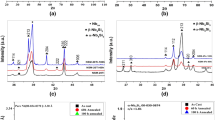Abstract
Methods of induction melting an ultra-low-density magnesium silicide (Mg2Si) intermetallic and its alloys and the resulting microstructure and microhardness were studied. The highest quality ingots of Mg2Si alloys were obtained by triple melting in a graphite crucible coated with boron nitride to eliminate reactivity, under overpressure of high-purity argon (1.3 X 105 Pa), at a temperature close to but not exceeding 1105 °C ± 5 °C to avoid excessive evaporation of Mg. After establishing the proper induction-melting conditions, the Mg-Si binary alloys and several Mg2Si alloys macroalloyed with 1 at. pct of Al, Ni, Co, Cu, Ag, Zn, Mn, Cr, and Fe were induction melted and, after solidification, investigated by optical microscopy and quantitative X-ray energy dispersive spectroscopy (EDS). Both the Mg-rich and Si-rich eutectic in the binary alloys exhibited a small but systematic increase in the Si content as the overall composition of the binary alloy moved closer toward the Mg2Si line compound. The Vickers microhardness (VHN) of the as-solidified Mg-rich and Si-rich eutectics in the Mg-Si binary alloys decreased with increasing Mg (decreasing Si) content in the eutectic. This behavior persisted even after annealing for 75 hours at 0.89 pct of the respective eutectic temperature. The Mg-rich eutectic in the Mg2Si + Al, Ni, Co, Cu, Ag, and Zn alloys contained sections exhibiting a different optical contrast and chemical composition than the rest of the eutectic. Some particles dispersed in the Mg2Si matrix were found in the Mg2Si + Cr, Mn, and Fe alloys. The EDS results are presented and discussed and compared with the VHN data.
Similar content being viewed by others
References
G. Simmons and H. Wang: inSingle Crystal Elastic Constants and Calculated Aggregate Properties, A Handbook, 2nd ed., MIT Press, Cambridge, MA, 1971, p. 215.
E.E. Schmid, K.V. Oldenburg, and G. Frommeyer:Z. Metallkd., 1990, vol. 81, pp. 809–15.
T.B. Massalski, J.I. Murray, L.L. Bennett, and H. Baker:Binary Alloy Phase Diagrams, ASM, Metals Park, OH, 1986, vols. 1-2.
R.A. Varin:Z. Metallkd., 1990, vol. 81, pp. 373–79.
K. Oldenburg, G. Frommeyer, E. Schmid, and W. Henning: inAdvanced Aluminum and Magnesium Alloys, T. Khan and G. Effenburg, eds., ASM Europe, 1990, pp. 477–84.
G. Albinger: inJava Jandel Video Analysis Software, Jandel Scientific Corte Madera, CA, 1988, p. 48.
R.A. Varin, G.H. Li, and H.S. Gill:Proc. Symp. on Processing and Fabrication of Advanced Materials for High Temperature Applications-II, V.A. Ravi and T.S. Srivatsan, eds., TMS, Warrendale, PA, 1993, pp. 127–40.
Author information
Authors and Affiliations
Additional information
Formerly
Formerly
Rights and permissions
About this article
Cite this article
Li, G., Gill, H.S. & Varin, R.A. Magnesium Silicide Intermetallic Alloys. Metall Trans A 24, 2383–2391 (1993). https://doi.org/10.1007/BF02646518
Received:
Published:
Issue Date:
DOI: https://doi.org/10.1007/BF02646518




